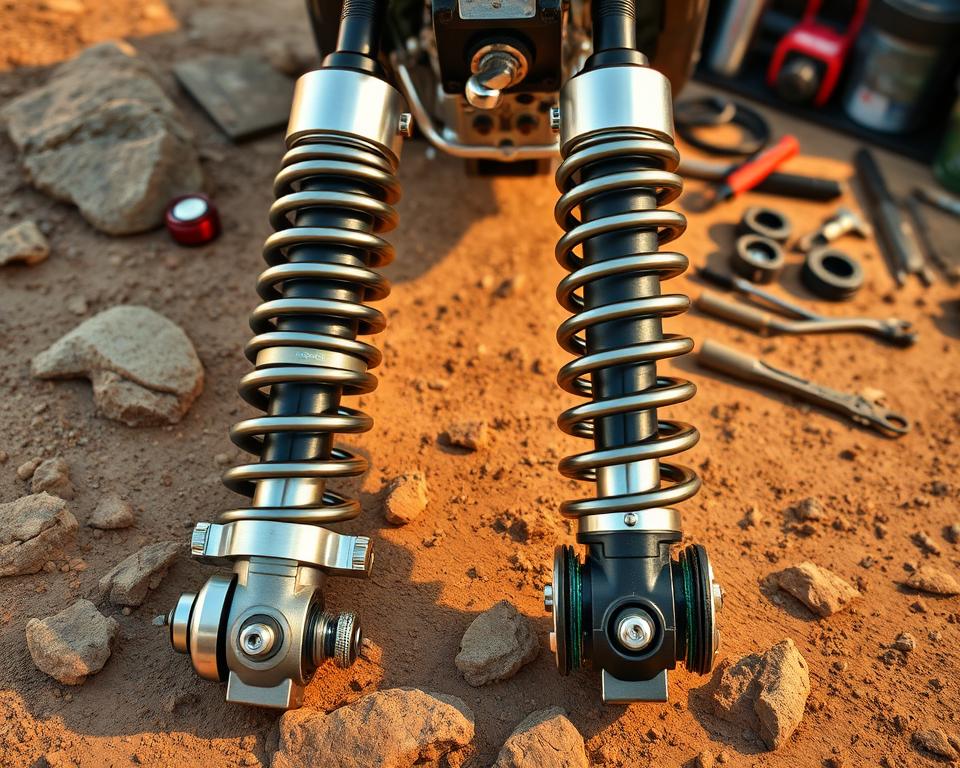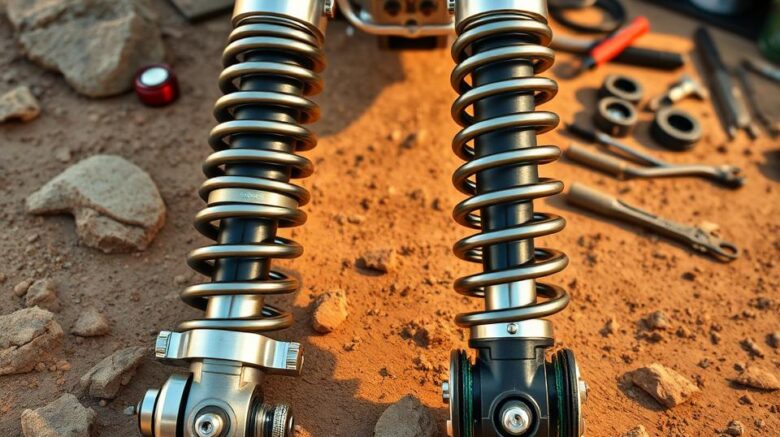Essential ATV Off-Road Checklist for Safe Riding
Are you aware nearly around 450,000 ATV-related injuries are treated in U.S. emergency rooms each year? This alarming figure highlights the need for safety and preparedness in off-road adventures. Here’s your go-to ATV Off-Road Checklist for maximum safety and enjoyment. From boulder-strewn tracks to shifting sands—it’s got you covered. Equipped with top safety gear plus moose ATV parts & accessories necessities, you’ll ride safer and with more confidence.
Critical Findings
- Start with safety: follow this checklist for full prep.
- An ATV safety gear checklist is vital for protecting yourself during off-road rides.
- Keep your ATV running smoothly with routine care.
- Hydration and nutrition boost endurance and focus on long rides.
- Learn to use navigation tools to avoid getting lost on off-road routes.
- Weather can flip fast—be ready with proper gear.
- Your tool and recovery kit can save the day on the trail.
Understanding the Importance of Safety Gear
When you ride off-road, safety must come first. Riding an ATV is thrilling but comes with risks. Safety gear is essential for protecting riders from accidents and injuries. Gear up correctly with this ATV safety gear checklist.

Essential Protective Gear
Maximizing protection involves several key items:
- Riding Helmets: Always use a DOT helmet to guard against head trauma.
- Goggles: Block dirt and grit with quality goggles.
- Gloves: Grip and guard your hands with sturdy gloves.
- Boots: Wear sturdy boots that cover the ankles to prevent injuries.
- Protective Armor: Wear armor to guard your torso on rough trails.
- Neck Protection: Support your neck to prevent serious injury.
Emergency Preparedness
Emergency preparedness is just as important as protective gear. An effective emergency kit can be a lifesaver in unexpected situations. Key items to include are:
- First aid kit
- Multi-tool
- Tire repair kits
- Portable air compressors
- Emergency blankets
- Whistles
- Matches
ATV Equipment for Optimal Performance
The right kit makes all the difference. Knowing the must-have ATV equipment ensures you’re ready for any journey. Use this maintenance checklist to keep your ride healthy.
Must-Have ATV Equipment
- All-Terrain Tires: Choose tires that grip mud, sand, and rocks.
- Storage Solutions: Mount racks or bags to carry your gear safely.
- Fuel Reservoir: Opt for a robust tank to avoid drips and dry runs.
- First Aid Kit: Stock your kit with bandages, antiseptic, and meds.
Regular Maintenance for Longevity
Establishing a consistent maintenance routine is vital. Regular inspections should encompass:
- Checking air filters to keep the engine running smoothly.
- A well-lubed chain spins quietly and reliably.
- Inspecting brakes for safety before each ride.
Stay on top of upkeep and your ATV will perform its best.
The Essential ATV Off-Road Checklist
Don’t skip your pre-ride safety scan. Use this pre-ride checklist to avert trouble before it starts. Every point matters—don’t rush. Spend a few minutes now for peace of mind later.
Pre-Ride Inspection Basics
Before any off-road journey, a pre-ride inspection is vital. Catch faults early with a fast inspection. Key elements to check include:
- Tire pressure and tread condition
- Fluid levels such as oil and fuel
- Brakes and controls functionality
- Operational lights and horn
- Chain or driveshaft integrity
T-CLOC Inspection Method
T-CLOC covers every critical system. Tires, Controls, Lights, Oil/Fuel, Chain—don’t miss a spot. This method ensures all critical areas are covered:
| Inspection Area | Checklist Items |
|---|---|
| Tires and Wheels | Check tire pressure, inspect tread depth, look for damage |
| Controls | Test brakes, throttle, and clutch for smooth operation |
| Lights | Ensure headlights, brake lights, and indicators are functioning |
| Oil and Fuel | Check oil level, inspect for leaks, and fill fuel tank |
| Chain/Driveshaft | Examine for wear, proper tension, and lubrication |
Check everything—ride with confidence. Prevent roadside repairs with a fast check.
Hydration and Nutrition for Long Rides
Don’t underestimate water and snacks on extended outings. Always carry more water than you think you’ll need. Hydration packs make water access easy on the trail. Pack high-energy bites to keep you going.
Importance of Staying Hydrated
Dehydration leads to poor decisions and slow reflexes. Sipping regularly prevents performance drops. Backpack reservoirs keep water flowing hands-free.
High-Energy Snacks to Pack
The right fuel makes the ride smoother. Opt for non-perishable items that are easy to consume. Some ideal choices include:
- Protein bars
- Nut mixes
- Dried fruits
- Beef jerky
These snacks provide a quick energy boost without hindering the riding experience. Mix sweet and salty options for flavor and function.
Navigation Tools for Off-Roading Adventures
Exploring uncharted territory demands reliable navigation tools. Don’t rely on luck or signals—use real navigation.
Advanced GPS Systems
High-end GPS units guide you through the wild. GPS should work without cell service and last all day. Brands like Garmin and TomTom offer models designed for off-road use, ensuring durability and precision.
Traditional Navigation Aids
Always carry a paper map along with your GPS. A compass never needs a signal. Wind your own way with map and compass skills. Combining advanced tech with traditional aids prepares you for any situation on your journey.
Communication Equipment for Safety
When phones fail, two-way radios deliver. Communication gear is as critical as your helmet. It gives riders peace of mind.
For seamless communication among group members, a quality two-way radio is highly recommended. These devices ensure clear audio over long distances. They allow for real-time updates on any changes or hazards. When choosing two-way radios, look for models with:
- Weatherproof construction to resist the elements
- Long battery life for extended trips without needing a recharge
- Channel selection for clear communication without interference
No ride is complete without radios. They keep everyone coordinated and secure. When reception is zero, your radio still works. Clear comms = better rides.
Self-Rescue Gear for ATV Riders
Don’t be caught unprepared—pack rescue gear. With the right kit, you’ll tackle obstacles solo. Prepared riders make safer group members.
Winches and Recovery Kits
Winches are vital for self-rescue, helping pull your ATV from tough spots. A winch paired with a detailed ATV recovery kit is even more effective. Recovery kits usually include:
- Tow straps
- D-rings
- Recovery boards
- Gloves
Practice recovery techniques before you need them. With quality ATV recovery kits, you can overcome mud, rocks, or other obstacles and continue your journey.
Trail Recovery Essentials
Winches are just the start; several trail recovery essentials are also critical for off-road adventures. These include:
| Equipment | Purpose |
|---|---|
| Recovery Straps | Used for towing or pulling ATVs out of tight situations. |
| Shovel | Helps clear obstacles and dig out vehicles when stuck. |
| Traction Mats | Provides grip under tires in muddy or slick conditions. |
| Portable Air Compressor | Enables quick tire inflation after deflating for better traction. |
Arming your ATV with the right self-rescue gear ensures you can handle any obstacles. Practice rescues so you’re ready when it counts.
Staying Adaptable: Preparing for Weather Changes
Trail weather can change in minutes. Your comfort and safety depend on proper weather prep. Pack for every possible forecast.
Dress in layers to stay comfortable. Start with wick-away fabrics. Then, add insulating layers like fleece or wool that can be removed as needed. Your shell fights off wind and rain. Adapt to cold, heat, or storms easily.
Weather-Appropriate Clothing
- Waterproof Jackets: Essential for keeping dry during unexpected rain showers.
- Ventilated Off-Road Pants: Allows for ventilation while protecting against wet conditions.
- UV Gear: Lightweight, long-sleeved shirts and wide-brimmed hats safeguard against harmful UV rays.
- Cold-Weather Gloves: Insulate your hands against cold snaps.
Quality weather gear is a must for a great off-roading experience. It keeps you comfortable and safe, letting you enjoy the adventure without worrying about the weather.
Tools for On-Trail Repairs
Essential repair tools are a rider’s best friend. It’s vital to carry reliable ATV repair tools. Fix flats and loose bolts in minutes.
Must-Have Tools and Kits
No ride is complete without a toolkit. A compact kit with everything you need. Critical ATV repair tools might include:
- Tire irons for changing flat tires
- Pliers for gripping and cutting
- Wrenches for various sizes of bolts and nuts
- A multi-tool for versatility
- Spare items such as spark plugs and electrical wire
- Duct tape for quick fixes
Tools at hand mean no surprises.
Basic Emergency Supplies
Emergency items can be lifesavers. These supplies help ensure your safety in challenging situations:
- First aid kit for injuries
- Flashlight with extra batteries for night-time visibility
- Emergency whistle for signaling assistance
- Reflective triangles or flares to warn other riders
- Water and high-energy snacks for sustenance
Preparedness significantly impacts your off-roading experience. Your safety net on the trail.
Bringing It All Together
Well-planned rides are the best rides. Check off each item and pick reputable brands. Be set for rocks, sand, mud—anything.
Load up on safety, navigation, and comms gear. Plan smart to ride hard and safe. Focus on fun, not fears.
Stay ready, ride with care, and enjoy the unforgettable moments off-roading offers. The journey is as important as the destination. By following the Essential ATV off-road checklist, you’re set for an incredible adventure in the great outdoors.
Frequently Asked Questions
What should I include in my ATV safety gear checklist?
Start with a DOT helmet and sturdy goggles. Don’t skip gloves, boots, and armor. Neck braces help guard your spine. Also bring a medical kit and adaptable multi-tool.
How do I keep my ATV in top shape?
Keep filters clean and chain well-lubed. Don’t ignore brake checks. Routine care prolongs longevity and readiness.
Explain the T-CLOC check.
T-CLOC is a five-step pre-ride routine. Cover Tires, Controls, Lights, Oil/Fuel, Chain in T-CLOC. T-CLOC confirms all systems go for trail use.
How to gauge water needs off-road?
Overestimate your water needs. Accurately estimating hydration needs prevents fatigue, which is critical during long rides. Use a hydration bladder for quick sips.
How to stay on course off-road?
For navigation, invest in an advanced GPS system designed for off-road use. Backup with maps and a compass ensures you never get lost.
Why is communication important when off-roading?
Comms keep groups connected and safe. Radios work where phones don’t.
Must-have self-rescue tools?
Every ATV rider should carry a winch and a detailed recovery kit. Have straps, shackles, mats, and gloves on hand.
Tips for weather readiness off-road?
To prepare for sudden weather changes, wear layered clothing that can be adjusted as temperatures change. Pack a rain shell to stay dry. Don’t forget sunscreen and UV-blocking apparel.
Key repair tools for ATVs?
A compact tool set lets you fix flats and loose bolts. Have spares and tape for quick fixes.
